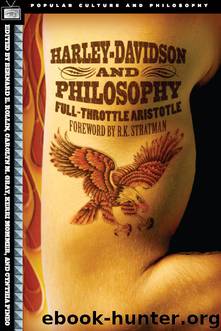Harley-Davidson and Philosophy by Bernard E. Rollin

Author:Bernard E. Rollin
Language: eng
Format: epub
ISBN: 9780812698077
Publisher: Open Court
Bikers with Attitudes
There are a whole host of theories concerning what it is to have an aesthetic appreciation of an object. Is there some special attitude that we must take towards a bike such that it counts as seeing it as an aesthetic object as opposed to something else? There is a tradition, of which the philosopher Immanuel Kant (1724–1804) is part, which takes “disinterest” as the characteristic attitude involved in aesthetic contemplation, where “disinterest” means that we have no interest in the practical uses of the object.3
Is disinterestedness, in this sense, the sort of attitude we take towards evaluating bikes? If it isn’t, then we can’t be evaluating the bike aesthetically, according to this theory. Luckily, though, we can adopt such an attitude towards bikes: I did it when searching around for my first bike! I didn’t need one for traveling around. I wasn’t even really aware of the sensual pleasures generated by twisting the throttle, leaning into corners, or braking heavily at high speed to reach crawling pace in a matter of a few seconds. No, I just fell in love with the look of the Ducati Monster; I bought one primarily on the basis of its styling. So not only is the disinterested attitude possible when contemplating bikes; it actually happens. And not just to me: in my experience, merely parking a Ducati in the street can draw a crowd of admirers who will just stand and stare for longer than they know they really should. The Harley V-Rod parked down the road has as many admirers.
The notion of disinterest also seems to capture to a certain extent our aesthetic experience: for when we are fully absorbed in an object such as a beautiful bike, we do feel a certain detachment from the world of practical affairs.
But it isn’t just the appearance of the bike that grounds the aesthetic evaluation of it. In order to aesthetically appreciate the object fully, certain contexts of evaluation have to be invoked, such as its history, the means by which it was produced, and other objects of its kind. Now, although not many people are aware of these contexts in any detail, they are at least aware of other things on offer to look at, and that there is something extraordinary, relative to the others, about the particular object before them. As David Daiches argues in the case of literature, in order to develop an aesthetic appreciation of objects, we need to encounter and engage with a wide range of possibilities: aesthetic appreciation is essentially comparative.4 And we can add that, because there is more or less to know about the contexts of evaluation as much as the internal structure of the work itself, aesthetic appreciation also comes by degrees. After all, to me the Ducati Monster still looks so much better than other bikes in the “urban warrior” style (a comparative context of evaluation). But it emerges as an even more remarkable achievement when we learn that it is over
Download
This site does not store any files on its server. We only index and link to content provided by other sites. Please contact the content providers to delete copyright contents if any and email us, we'll remove relevant links or contents immediately.
| Anthropology | Archaeology |
| Philosophy | Politics & Government |
| Social Sciences | Sociology |
| Women's Studies |
The remains of the day by Kazuo Ishiguro(8751)
Tools of Titans by Timothy Ferriss(8159)
Giovanni's Room by James Baldwin(7119)
The Black Swan by Nassim Nicholas Taleb(6950)
Inner Engineering: A Yogi's Guide to Joy by Sadhguru(6636)
The Way of Zen by Alan W. Watts(6454)
Asking the Right Questions: A Guide to Critical Thinking by M. Neil Browne & Stuart M. Keeley(5579)
The Power of Now: A Guide to Spiritual Enlightenment by Eckhart Tolle(5547)
The Six Wives Of Henry VIII (WOMEN IN HISTORY) by Fraser Antonia(5360)
Astrophysics for People in a Hurry by Neil DeGrasse Tyson(5097)
Housekeeping by Marilynne Robinson(4256)
12 Rules for Life by Jordan B. Peterson(4220)
The Ethical Slut by Janet W. Hardy(4149)
Double Down (Diary of a Wimpy Kid Book 11) by Jeff Kinney(4147)
Skin in the Game by Nassim Nicholas Taleb(4125)
Ikigai by Héctor García & Francesc Miralles(4047)
The Art of Happiness by The Dalai Lama(4011)
Skin in the Game: Hidden Asymmetries in Daily Life by Nassim Nicholas Taleb(3870)
Walking by Henry David Thoreau(3860)
